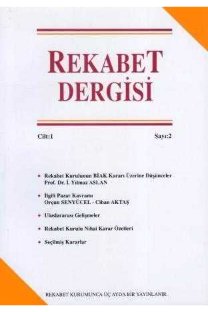REKABET HUKUKU BOYUTUYLA YENİ NESİL MOBİL İLETİŞİM HİZMETLERİ PAZARINDA İŞBİRLİĞİ ANLAŞMALARI
Yeni nesil mobil iletişim alanındaki işletmecilerin rekabet stratejileri, şebekelerini en kısa sürede, en düşük maliyetle kurarak ilgi çekici katma değerli hizmetleri makul fiyatlarla kullanıcılara sunma prensibine dayanmaktadır. Bu alandaki düzenleyici ortam, teknoloji, lisans ücretlerinin ve şebeke kuruluşunun yarattığı ciddi maliyet, bu amaca ulaşmak isteyen işletmecileri çeşitli işbirliği anlaşmaları yapmaya yönlendirmektedir. Söz konusu işbirlikleri, altyapıların rakip işletmecilerce birlikte kurulması ve işletilmesine yönelik ortak girişimler, şebekenin paylaşılmasına ilişkin anlaşmalar, içerik/yazılım sağlayıcı, uygulama programları üreticileri ya da cihaz üreticisi firmalarla yapılan işbirlikleri gibi çeşitli seviyelerde ve şekillerde artarak yapılagelmektedir
Anahtar Kelimeler:
Mobil Đletişim, 3. Nesil, Đşbirliği Anlaşmaları, Şebeke Paylaşımı, Kapanma Etkisi
COLLABORATIVE AGREEMENTS IN NEW GENERATION MOBILE COMMUNICATIONS MARKET FROM COMPETITION LAW PERSPECTIVE
The competition strategy of the new generation mobile communications operators depends on the rapid roll-out of their network for minimum cost and providing interesting value added services for fair prices to consumers. The burdens created by regulatory environment, technological requirements and significant cost of licenses and deployment of networks drive operators to participate in collaborative agreements in order to achieve this purpose. Such agreements are increasingly being made at various levels and models i.e. in the form of joint ventures to co-build and operate the infrastructures or agreements to share networks, or cooperation agreements between operators and content/software manufacturers. providers, application providers and equipment
___
- BİLGİ TEKNOLOJİLERİ VE İLETİŞİM KURUMU (2010), “İstatistiki Veriler Işığında Türkiye’de ve Dünyada Elektronik Haberleşme Sektörü”, Ankara.
- BİLGİ TEKNOLOJİLERİ VE İLETİŞİM KURUMU (2011), “Türkiye Elektronik Haberleşme Sektörü, Üç Aylık Pazar Verileri Raporu, 2010 yılı 4. Çeyrek”, Sayı: 12, Ankara.
- CASTELLOT PENA, M. A. (1995), “The application of competition rules in the telecommunications sector: strategic alliances”, Competition Policy Newsletter, No: 4, V. 1, Spring 1995, s.1-6.
- ERICSSON (2001), White Paper on Basic Concepts on WCDMA Radio Access Network, http://www.cccericsson.com/Request/001.pdf
- Erişim Tarihi: 15.12.2010.
- EUROPEAN COMMISSION (1997), Green Paper on the Convergence of the Telecommunications, Media and Information Technology Sectors, and The Implications for Regulation, COM (97)623, 3 December 1997.
- EUROPEAN COMMISSION (2005), Paper on the Preliminary Findings of the Sector Inquiry into New Media (3G), Brussels.
- FELDMANN, V. (2002), “Competitive strategy for media companies in the mobile Internet”, Schmalenbach Business Review, V. 54, October 2002, s. 351-371.
- FUENTELSAZ, L., MAICAS, J.P. ve Y. POLO (2008), “The Evolution of mobile communicatios in Europe: The transition from the second to the third generation”, Telecommunications Policy 32, s.436-449.
- GABATHULER, D. ve W. SAUTER (2003), “Network Sharing in 3rd Generation Mobile Communications Systems: Minding the Coverage Gap and Complying with EC Competition Rules”, Competition Policy Newsletter, Autumn, No. 3, s.43-46.
- GARZANITI, L. (2003), Telecommunications, Broadcasting and the Internet: EC Competition Law and Regulation.
- GERADIN, D. (2005), “Access to Content by new media platforms: a review of the competition law problems”, European Law Review, February 2005, s.2-28.
- JONES, A. ve SUFRIN, B. (2004), EC Competition Law, Oxford.
- KROES, N. (2010), Speech, “European Commission and European Parliament Summit on The Open Internet and Net Neutrality in Europe” Brüksel, 11 Kasım 2010.
- http://europa.eu/rapid/pressReleasesAction.do?reference=SPEECH/10/643 (30.11.2010).
- MAITLAND, C. F., BAUER, J. M. ve R. WESTERVELD (2002), “The European market for mobile data: evolving value chains and industry structures”, Telecommunications Policy 26, s.485-504.
- MONTI, M. (2001), Speech/01/375 on Defining the boundaries competition policy in high tech sectors, 11.9.2001.
- MONTI, M. (2004), Speech/04/353 on Access to content and the development of competition in the New Media market- the Commission’s approach, 8.7.2004. NIKOLINAKOS, N. T. (2004), “Mergers and Strategic Alliances in the emerging multimedia sector: The EU Competition Policy, European Competition Law Review, 25(10), s.625-637.
- NIKOLINAKOS, N. T. (2005), “EU competition law on access to premium content: the emergence of new media”, Computer and Telecommunications Law Review, Jan., V. 11, Is. 1, s.13-16.
- OECD (2003), Development of 3G Mobile Services, DSTI/ICCP/TISP(2003) 10/Final.
- PETIT, N. (2004), “The Commission’s contribution to the emergence of 3G mobile telecommunications: An analysis of some decisions in the field of competition law”, European Competition Law Review, s.2-15.
- PITT, E. (2005), “Competition Law in Telecommunications”, I. WALDEN, ve J. ANGEL (der.), Telecommunications Law and Regulation içinde, Oxford.
- RABASSA, V. ve G. B. ABBAMONTE (2001), “Foreclosure and Vertical mergers - The Commission’s Review of Vertical Effects In the last Wave of Media and Internet Mergers: AOL/Time Warner, Vivendi/Seagram, MCI WorldCom/Sprint”, European Competition Law Review, 22(6), s.214-226.
- STEWART, J. (2004), “Mobile Internet and Rich Voice Plus: the Social Shaping of Convergence”, RCSS, University of Edinburgh, Working paper for WWRF workshop Oslo 10-11 June 2004 based on research done as part of IST funded FLOWS project on simultaneous use of standards using MIMO1
- http://homepages.ed.ac.uk/jkstew/work/Stewart_WWRF_WG2_June2004.pdf
- Erişim Tarihi: 15.12.2010. WILLET
- Telecommunications Market”, Speech at AMTA Annual Conference, 15 September 2005, http://www.accc.gov.au/content/index.phtml/itemId/708300, Erişim Tarihi: 01.12.2010. “Regulating Competition in the Mobile
- ISSN: 1302-552X
- Yayın Aralığı: Yılda 5 Sayı
- Başlangıç: 2000
- Yayıncı: Rekabet Kurumu
Sayıdaki Diğer Makaleler
ALACAĞIN TEMLİKİ YOLUYLA KOLLEKTİF TAZMİNAT TALEPLERİNE İMKÂN VEREN BİR MODEL GELİŞTİRİLEBİLİR Mİ?
ABD, AB VE TÜRK REKABET HUKUKUNDA TAZMİNAT DAVALARININ ÖNÜNDEKİ USULİ ENGELLER
REKABET HUKUKU BOYUTUYLA YENİ NESİL MOBİL İLETİŞİM HİZMETLERİ PAZARINDA İŞBİRLİĞİ ANLAŞMALARI
